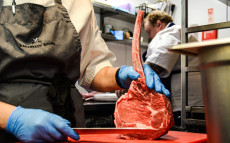- pathfindersAI
- Job Profile
Slaughterers and Meat Packers
Summary
Slaughterers and Meat Packers
What They Do
Slaughterers and Meat Packers occupy a vital niche within the food production industry. These professionals are responsible for the preparation of meat products for consumer markets. They ensure that livestock is humanely slaughtered and processed efficiently to meet safety and regulatory standards. The scope of their work extends from the initial stages of animal slaughter to the packaging and distribution of meat products. This essential role supports not only the food supply chain but also upholds standards that protect animal welfare and public health.
Job Responsibilities
The job responsibilities of Slaughterers and Meat Packers are multifaceted and demanding. Initially, these professionals are involved in the humane slaughter of livestock, ensuring compliance with health and safety regulations. They are required to inspect the livestock for health conditions and process them accordingly. Following the slaughter, they skillfully separate the carcass into various parts, categorizing them based on quality and type. The subsequent stages involve trimming, deboning, and grinding meat as necessary. Finally, meat packers wrap, weigh, and label the products for distribution. Throughout all these processes, adherence to stringent hygiene and safety protocols is crucial to prevent contamination and ensure product quality.
Essential Skills
Individuals aspiring to become Slaughterers and Meat Packers must possess a robust set of skills. Key among these is manual dexterity and physical stamina, as the job often involves repetitive motions and standing for extended periods. Attention to detail is critical to ensure precision in cutting and packaging. A comprehensive understanding of safety and hygiene practices is also essential to maintain a safe working environment and produce high-quality meat products. Interpersonal skills and the ability to work collaboratively within a team setting further enhance the efficiency and morale of the workforce. Adaptability and problem-solving skills are also beneficial in addressing any operational challenges that may arise.
Educational Pathways
The educational pathways leading to a career as a Slaughterer and Meat Packer are relatively accessible. A high school diploma or equivalent is typically the minimum educational requirement. Relevant coursework in agricultural science, animal husbandry, or culinary arts can provide foundational knowledge beneficial to the role. Some meat processing facilities offer on-the-job training programs that cover essential skills and safety protocols. For those seeking to advance within the industry, enrolling in certificate or associate degree programs in meat science or food safety can provide a competitive edge. Additionally, certification from recognized organizations such as the American Meat Science Association can enhance job prospects and demonstrate professional competence.
Career Prospects
Career prospects for Slaughterers and Meat Packers remain stable due to the consistent demand for meat products. Entry-level positions provide opportunities to gain hands-on experience and master essential skills. With dedication and continued education, individuals can advance to supervisory roles or specialize in areas such as meat inspection or quality control. The evolving landscape of the food production industry, driven by advancements in technology and changing consumer preferences, also opens up new avenues for career growth. The role serves as a stepping stone to various related fields, including food safety regulation, agricultural management, and culinary arts.
Conclusion
In conclusion, the profession of Slaughterers and Meat Packers plays an indispensable role in the food production industry, ensuring a steady supply of safe and high-quality meat products. The job entails a range of responsibilities from humane animal slaughter to meticulous meat packaging, requiring a diverse skill set. Educational pathways to this career are accessible, and there are ample opportunities for professional growth and advancement. Those who embark on this career path will find themselves contributing significantly to a crucial sector, one that sustains not only the economy but also the wellbeing of communities.
Video
Compensation
| State | Median Salary | Median Hourly | Positions |
|---|---|---|---|
| AZ | 45,140 | 21.70 | 240 |
| AR | 35,140 | 16.89 | 1,060 |
| CA | 36,810 | 17.70 | 8,040 |
| CT | 33,890 | 16.29 | 60 |
| FL | 30,690 | 14.76 | 840 |
| GA | 35,060 | 16.86 | 4,010 |
| HI | 36,190 | 17.40 | 170 |
| ID | 35,480 | 17.06 | 230 |
| IL | 44,380 | 21.34 | 3,150 |
| IN | 37,060 | 17.82 | 1,080 |
| IA | 39,540 | 19.01 | 4,800 |
| KS | 45,450 | 21.85 | 2,290 |
| KY | 33,380 | 16.05 | 1,510 |
| LA | 36,150 | 17.38 | 610 |
| ME | 35,340 | 16.99 | 70 |
| MA | 35,200 | 16.92 | 80 |
| MI | 39,790 | 19.13 | 1,360 |
| MN | 39,590 | 19.04 | 2,990 |
| MS | 34,660 | 16.66 | 3,390 |
| MO | 43,430 | 20.88 | 1,400 |
| MT | 38,590 | 18.55 | 110 |
| NE | 45,740 | 21.99 | 5,000 |
| NV | 37,530 | 18.04 | 100 |
| NH | 31,290 | 15.04 | 30 |
| NJ | 37,710 | 18.13 | 370 |
| NY | 35,100 | 16.88 | 750 |
| NC | 36,940 | 17.76 | 7,570 |
| ND | 35,430 | 17.03 | 120 |
| OH | 36,460 | 17.53 | 930 |
| OK | * | * | 1,610 |
| OR | 38,340 | 18.43 | 420 |
| PA | 37,060 | 17.82 | 1,850 |
| RI | 38,980 | 18.74 | 260 |
| SC | 32,170 | 15.47 | 610 |
| SD | 40,790 | 19.61 | 740 |
| TN | 34,090 | 16.39 | 1,050 |
| TX | 38,950 | 18.73 | 5,780 |
| UT | 36,820 | 17.70 | 1,150 |
| VA | 34,500 | 16.59 | 620 |
| WA | 42,440 | 20.40 | 1,090 |
| WV | 19,850 | 9.54 | 160 |
| WI | 35,920 | 17.27 | 2,570 |
Similar Occupations
In this area you will find other occupations that are close to the one you were viewing in tasks, knowledge and work environment. If the primary job profile you are viewing isn't quite to your liking, take a look around and see what else is available.
Basic and Premium Accounts have more alternative occupations available than the Free account.

Animal Breeders - 45-2021.00
Animal breeders selectively mate animals to produce offspring with desired traits, such as superior physical characteristics, health, or temperament. They monitor genetics, health, and lineage to ensure high-quality results, often specializing in particular breeds or species.
-
$47,540/yr
Median Pay -
1,360
Number of Jobs

Butchers and Meat Cutters - 51-3021.00
Butchers and Meat Cutters are professionals responsible for preparing meat for consumer use by slaughtering, deboning, trimming, and cutting into various types of cuts, ensuring optimal quality and portion control. They also handle the storage, packaging, and display of meat products, adhering to sanitary and safety standards.
-
$37,650/yr
Median Pay -
136,330
Number of Jobs